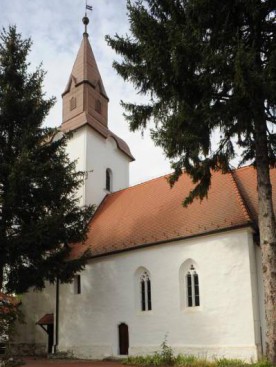The Calvinist Church – BeregdarócInitially, the settlement Daróc – located on the Bereg plains – was inhabited by hunters in the king’s service, but became later, at the end of the 13th century, a possession of the Daróci family belonging to the Gutkeled clan. The first indirect mentioning of its church stems from the beginning of the 14th century, when the local priest called Benedek (Benedict) was listed in the register on the Papal Tenth. The first actual mentioning of the church stems from 1423, while in 1435 the church was mentioned again, on this occasion, as a stone edifice without tower. A diploma issued in 1465 tells us that it had been dedicated to Saint Martin. By the end of the 15th century a mansion was already standing next to the church. The remains of this building were found during an archaeological excavation. In 1595, the church belonged to the Calvinists already. In the year 1862, a massive fire devastated Daróc, which damaged the priest’s residence, the school and the church, too. Unfortunately, the murals stemming from the second half of the 15th century were destroyed during the restoration following the fire from 1862. More precisely, the church was rebuilt after the fire. At this moment of time the western stone tower was already in place, since it had been erected in 1838. Accounts speak of frescoes representing saints and bishops inside the sanctuary. The church had an unmistakable medieval aspect even before the restoration performed in 1991, that is, the nave of the oriented building was connected to a sanctuary enclosed by three sides of an octagon. Explorations of the monument and archaeological excavations, which took place between 1991 and 1994, revealed the remains of walls belonging to an early church built of bricks and having a semicircular apse. The predecessor of the present church, to which no tower was attached, had been built after tearing this early church down. The new vaulted sanctuary has no buttresses and is enclosed by several sides of a polygon. The details of the sanctuary – such as the coats of arms on the cornerstones of the vault and the cornice decorations on canopies – help us in dating the church. These architectural details present various resemblances to the ones of the Roman Catholic church in Beregszász/Berehove and, hence, must have been made between 1380 and 1400. The nave was modified later, around 1465, the western gate was opened at that time, too, but it was transferred to another part of the church later. The architectural reconstruction carried out according to plans drafted by György Szekér aimed at achieving the necessary structural fortifications in a harmonious unity with an authentic presentation of the church’s historical values. Medieval stone fragments have been reinserted in their original locations recreating thus most of the interior space as it was originally shaped around 1500. |















